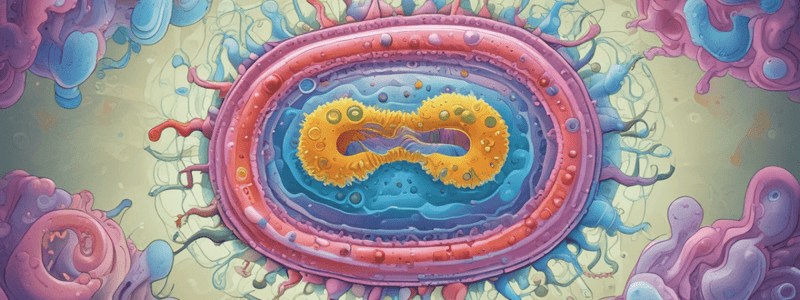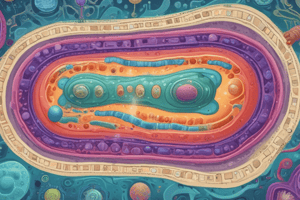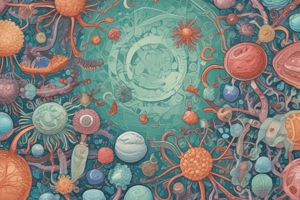Podcast
Questions and Answers
What is the function of the plasma membrane in prokaryotes?
What is the function of the plasma membrane in prokaryotes?
- Provides energy to the cell through photosynthesis
- Contains genetic material and ribosomes
- Regulates the flow of materials in and out of the cell (correct)
- Provides shape and support to the cell
What is unique about the genetic material in prokaryotes?
What is unique about the genetic material in prokaryotes?
- It is single-stranded
- It is a single circular chromosome found in the cytoplasm (correct)
- It is found in multiple circular chromosomes
- It is found in a true nucleus
Which of the following adaptations allows prokaryotes to survive in extreme temperatures?
Which of the following adaptations allows prokaryotes to survive in extreme temperatures?
- Radioresistant
- Thermophilic and psychrophilic (correct)
- Halophilic
- Anaerobic
What is the function of nitrogen fixation in prokaryotes?
What is the function of nitrogen fixation in prokaryotes?
What is a characteristic of prokaryotes that allows them to thrive in diverse environments?
What is a characteristic of prokaryotes that allows them to thrive in diverse environments?
Which of the following is NOT a metabolic process in prokaryotes?
Which of the following is NOT a metabolic process in prokaryotes?
What is the role of prokaryotes in ecosystem processes?
What is the role of prokaryotes in ecosystem processes?
What is a characteristic of anaerobic prokaryotes?
What is a characteristic of anaerobic prokaryotes?
What is unique about the cell structure of prokaryotes?
What is unique about the cell structure of prokaryotes?
Which of the following is an example of a metabolic process in prokaryotes?
Which of the following is an example of a metabolic process in prokaryotes?
Flashcards are hidden until you start studying
Study Notes
Cell Structure
- Prokaryotes are single-celled microorganisms that lack a true nucleus.
- They have a simple cell structure, consisting of:
- Cell wall: provides shape and support
- Plasma membrane: regulates the flow of materials in and out of the cell
- Cytoplasm: contains genetic material, ribosomes, and various metabolic components
- Genetic material: single circular chromosome (DNA) found in the cytoplasm
- No membrane-bound organelles, such as mitochondria or chloroplasts, are present.
Evolutionary Adaptations
- Prokaryotes have evolved various adaptations to survive in diverse environments:
- Extreme temperatures: thermophilic (heat-loving) and psychrophilic (cold-loving) species
- High salinity: halophilic (salt-loving) species
- Low oxygen: anaerobic species
- Radiation: radioresistant species
- These adaptations allow prokaryotes to thrive in environments where other organisms cannot survive.
Metabolic Processes
- Prokaryotes have diverse metabolic processes, including:
- Photosynthesis: some species, such as cyanobacteria, can convert light energy into chemical energy
- Respiration: aerobic and anaerobic species use different electron acceptors to generate energy
- Fermentation: anaerobic species break down organic compounds to generate energy
- Nitrogen fixation: some species can convert atmospheric nitrogen into a usable form
- Prokaryotes play a crucial role in many ecosystem processes, such as decomposition, nutrient cycling, and primary production.
Reproduction
- Prokaryotes reproduce primarily through:
- Binary fission: a process of cell division that results in two identical daughter cells
- Fragmentation: some species can break apart and grow into new individuals
- Spore formation: some species can form dormant, highly resistant spores that can survive extreme conditions
- Prokaryotes can also exchange genetic material through horizontal gene transfer, which allows for rapid adaptation to changing environments.
Cell Structure
- Prokaryotes lack a true nucleus and have a simple cell structure consisting of a cell wall, plasma membrane, cytoplasm, and genetic material.
- The cell wall provides shape and support, while the plasma membrane regulates the flow of materials.
- The cytoplasm contains genetic material, ribosomes, and various metabolic components.
- Genetic material is composed of a single circular chromosome (DNA) found in the cytoplasm.
- Prokaryotes do not have membrane-bound organelles such as mitochondria or chloroplasts.
Evolutionary Adaptations
- Prokaryotes have evolved adaptations to survive in diverse environments, including:
- Thermophilic (heat-loving) species that thrive in extreme temperatures.
- Halophilic (salt-loving) species that can survive in high-salinity environments.
- Anaerobic species that can survive in low-oxygen environments.
- Radioresistant species that can resist radiation.
- These adaptations enable prokaryotes to thrive in environments where other organisms cannot survive.
Metabolic Processes
- Prokaryotes have diverse metabolic processes, including:
- Photosynthesis: converting light energy into chemical energy (found in cyanobacteria).
- Respiration: using different electron acceptors to generate energy (aerobic and anaerobic species).
- Fermentation: breaking down organic compounds to generate energy (anaerobic species).
- Nitrogen fixation: converting atmospheric nitrogen into a usable form (some species).
- Prokaryotes play a crucial role in ecosystem processes, such as decomposition, nutrient cycling, and primary production.
Reproduction
- Prokaryotes reproduce primarily through:
- Binary fission: resulting in two identical daughter cells.
- Fragmentation: breaking apart and growing into new individuals (some species).
- Spore formation: forming dormant, highly resistant spores that can survive extreme conditions.
- Prokaryotes can also exchange genetic material through horizontal gene transfer, allowing for rapid adaptation to changing environments.
Studying That Suits You
Use AI to generate personalized quizzes and flashcards to suit your learning preferences.




